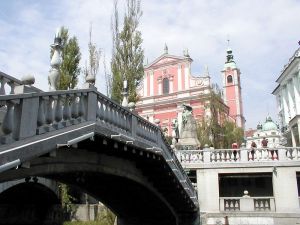Ljubljana
|
|

Ljubljana (IPA ), German Laibach (), Italian Lubiana () is the capital of Slovenia, situated on the outfall of the river Ljubljanica into the Sava, in central Slovenia, between the Alps and the Mediterranean. Population: 265,881 (2002).
It is located at 46.03°N, 14.30°E at an altitude of 298 meters above sea level. The temperature varies between 3.4°C (38.1 °F) in January and 21.9°C (71.4 °F) in July. Annual rainfall is 1350 mm (53.2 inches).
Historians disagree as to where the name comes from. Although it is commonly pointed out that it originates out of the Slovenian word ljubljena (a feminine form of beloved), this is not known for certain. The name may just as well have evolved from the Latin term for a flooding river, aluviana. Some also believe the source of the present-day name is Laburus, an old Slavonic deity and supposed patron of the original settlement. And Laibach, the German name for the city, may have borrowed itself from Laubach (a lukewarm beck, in German).
Although the Roman settlement Emona (Colonia Emona (Aemona) Iulia tribu Claudia) was erected in 15 AD, the first records mentioning Ljubljana by its modern name date to 1144 (by its German name Laibach) and 1146 (by name Luwigana).
Ljubljana_cathedral.jpg
Ljubljana-skyline.jpg
After receiving its town rights in 1220, Ljubljana came under Habsburg rule in 1335, became the seat of the diocese in 1461, and developed into a Slovenian cultural centre during the late Middle Ages. The Habsburg rule was only interrupted by the Napoleonic wars, and between 1809 and 1813 Ljubljana was the capital of the French Illyrian provinces. In 1821 the city hosted the Congress of Laibach. While under Austrian rule, Ljubljana was the capital of Carniola.
With the collapse of the Austro-Hungarian Empire in 1918, Ljubljana became the seat of the Dravska banovina. In April 1941 it was occupied by Italy and on February 23 1942 Italians completely encircled it with 32 km of barbwire and thus effectively turned it into the largest war camp in Europe with very restricted access through checkpoints. For that it was the first Yugoslav city granted a status of Town - Hero after the war.
After World War II it was the capital of the Yugoslav socialist republic of Slovenia. Ljubljana remained the capital city when Slovenia gained independence in 1991.
Ljubljana was devastated by earthquakes several times. After the earthquake in 1511, Ljubljana was rebuilt in the Renaissance style, and after the earthquake 1895 severely damaged the city, in Neo-Classicist and Secession (Art Nouveau) styles. The city's architecture is thus a mixture of styles. Large areas of city built between the two world wars feature the work of native architect Jože Plečnik.
In 1693, a scholarly society Academia operosorum Labacensis was established in Ljubljana, followed by the Philharmonic Society (Academia philharmonicorum) in 1701. Ljubljana formed its university in 1919 and the National Academy of Sciences and Arts in 1937.
See also
External links
- Official website of city hall (http://www.ljubljana.si/)
- Tourism office (http://www.ljubljana-tourism.si/)
- Ljubljana Hotels Reservation and Travel Tips (http://www.ljubljanatravel.com/)
Template:Slovenia-municipalitiesbg:Любляна bs:Ljubljana ca:Ljubljana cs:Lublaň de:Ljubljana et:Ljubljana es:Liubliana fr:Ljubljana io:Ljubljana it:Lubiana mk:Љубљана nl:Ljubljana ja:リュブリャナ no:Ljubljana pl:Lublana ro:Ljubljana ru:Любляна sl:Ljubljana sr:Љубљана fi:Ljubljana sv:Ljubljana zh:卢布尔雅那

